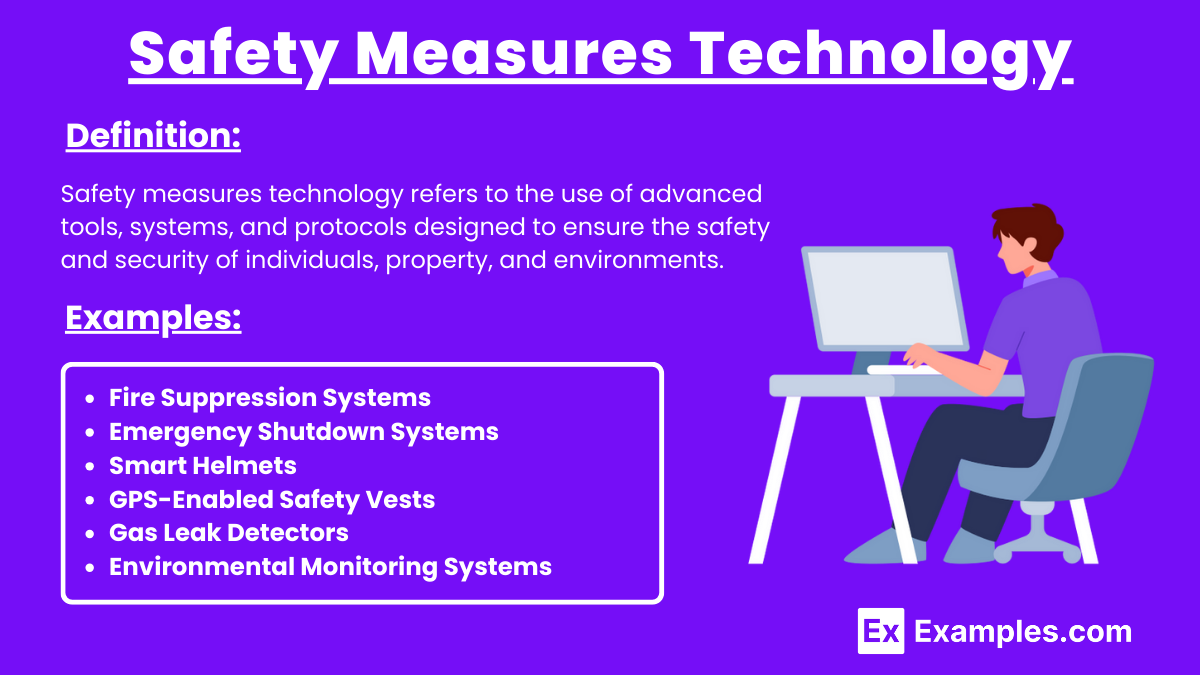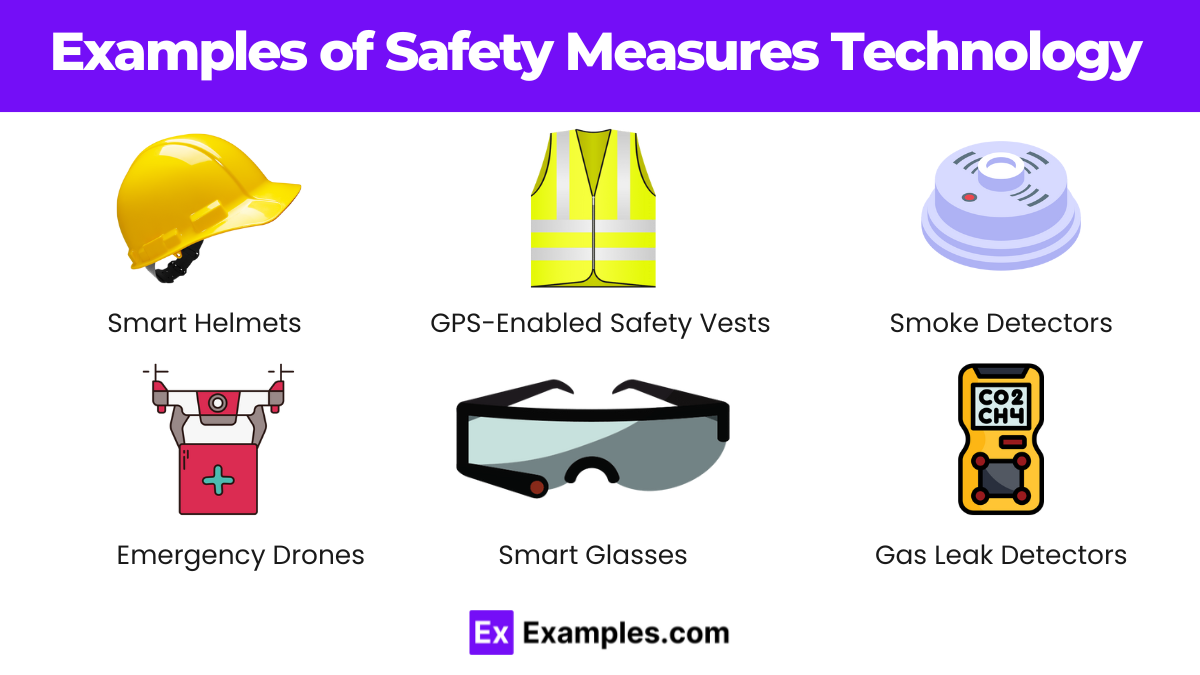Which technology is commonly used to detect fire and smoke in buildings?
Carbon monoxide detectors
Smoke alarms
Motion sensors
Water meters


Safety measures technology refers to the use of advanced tools, systems, and protocols designed to ensure the safety and security of individuals, property, and environments. This technology encompasses a wide range of applications, including surveillance systems, automated emergency response systems, wearable safety devices, and integrated health monitoring systems. By leveraging innovations such as artificial intelligence, the Internet of Things (IoT), and real-time data analysis, safety measures technology aims to prevent accidents, reduce risks, and enhance overall safety across various sectors, including industrial, commercial, residential, and public spaces.
Safety Measures Technology refers to the application of innovative tools, systems, and devices designed to enhance safety and prevent accidents across various environments, such as workplaces, homes, and public spaces. This technology encompasses a wide range of solutions, including automated safety systems, wearable safety devices, hazard detection sensors, and real-time monitoring software.
Safety measures are protocols, guidelines, and practices implemented to prevent accidents, injuries, and hazards in various environments, such as workplaces, homes, schools, and public areas. These measures are designed to protect individuals, property, and the environment by minimizing risks and ensuring a safe and healthy environment. Safety measures include the use of protective equipment, adherence to safety regulations, regular maintenance of equipment, safety training programs, emergency preparedness plans, and the implementation of safety technologies. Effective safety measures not only help in avoiding accidents but also promote a culture of safety awareness and responsibility.
Technology plays a pivotal role in modern society, influencing almost every aspect of our daily lives. Its contributions span across various fields, enhancing efficiency, connectivity, and overall quality of life. Here are some key roles of technology:

1. Automated Safety Systems: This category includes automatic shutdown mechanisms, emergency stop systems, and fail-safe designs. These systems are common in industrial settings to prevent machinery accidents.
2. Wearable Safety Devices: Wearables such as smart helmets, vests, and wristbands are equipped with sensors to monitor workers’ health, detect falls, and provide real-time location tracking.
3. Hazard Detection Sensors: These sensors detect environmental hazards like gas leaks, fire, and radiation, and include devices such as smoke detectors, carbon monoxide detectors, and chemical sensors.
4. Real-Time Monitoring Software: Software platforms collect and analyze data from various safety devices, providing alerts and insights for proactive risk management.
5. Surveillance and Security Systems: This includes CCTV cameras, access control systems, and intrusion detection, all of which enhance security and monitor unauthorized access.
Safety Measures Technology finds applications across various fields to enhance safety and prevent accidents. Here are some key applications:
It reduces workplace accidents, improves compliance with safety regulations, and enhances overall employee well-being and productivity.
Common types include surveillance systems, fire detection and suppression systems, emergency communication systems, and personal protective equipment (PPE).
Surveillance systems monitor activities, deter criminal behavior, and provide real-time footage for quick response to emergencies.
AI analyzes data from safety systems to predict potential hazards, automate responses, and improve decision-making processes.
They use sensors to detect smoke, heat, or flames and trigger alarms and suppression systems to control fires.
Personal protective equipment shields individuals from specific hazards, such as chemicals, electrical risks, and physical impacts.
Wearable safety devices, like smart helmets and vests, monitor workers’ health and environmental conditions to prevent accidents.
The Internet of Things (IoT) connects safety devices, enabling real-time monitoring and data analysis to predict and prevent hazards.
Predictive maintenance uses data analytics to forecast equipment failures, allowing for timely repairs and preventing accidents.
The future includes advancements in AI, IoT, and wearable tech, leading to more proactive, intelligent safety solutions.
Text prompt
Add Tone
10 Examples of Public speaking
20 Examples of Gas lighting
Which technology is commonly used to detect fire and smoke in buildings?
Carbon monoxide detectors
Smoke alarms
Motion sensors
Water meters
What is the purpose of a safety interlock system in machinery?
To increase production speed
To prevent accidental operation
To enhance aesthetic appeal
To reduce energy consumption
Which type of technology is used to monitor and control access to secure areas?
Thermal imaging
Biometric systems
Smart thermostats
Noise sensors
What does a safety audit typically assess in a workplace?
Financial performance
Employee satisfaction
Compliance with safety regulations
Market trends
Which technology helps in real-time monitoring of industrial processes to prevent accidents?
Automated Guided Vehicles (AGVs)
Supervisory Control and Data Acquisition (SCADA)
Geographic Information Systems (GIS)
Building Management Systems (BMS)
What is the role of Personal Protective Equipment (PPE) in safety technology?
To improve workplace productivity
To protect individuals from hazards
To enhance communication
To manage inventory
Which technology is used to alert drivers of potential collisions?
Adaptive cruise control
Lane departure warning
Collision avoidance systems
Tire pressure monitoring
How does a gas leak detector contribute to safety in industrial environments?
By regulating temperature
By measuring noise levels
By detecting hazardous gas leaks
By controlling lighting
What is the primary function of fire suppression systems in buildings?
To cool the building
To filter air
To extinguish or control fires
To monitor energy usage
Which safety technology is used to protect electronic devices from power surges?
Circuit breakers
Surge protectors
Voltage regulators
Backup generators
Before you leave, take our quick quiz to enhance your learning!

